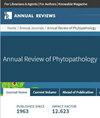Re-Envisioning the Plant Disease Triangle by Integration of Host Microbiota and a Pivot in Focus to Health Outcomes
IF 11.9
1区 农林科学
Q1 PLANT SCIENCES
引用次数: 0
Abstract
The disease triangle is a structurally simple but conceptually rich model that is used in plant pathology and other fields of study to explain infectious disease as an outcome of the three-way relationship between a host, a pathogen, and their environment. It also serves as a guide for finding solutions to treat, predict, and prevent such diseases. With the omics-driven, evidence-based realization that the abundance and activity of a pathogen are impacted by proximity to and interaction with a diverse multitude of other microorganisms colonizing the same host, the disease triangle evolved into a tetrahedron shape, which features an added fourth dimension representing the host-associated microbiota. Another variant of the disease triangle emerged from the recently formulated pathobiome paradigm, which deviates from the classical “one pathogen” etiology of infectious disease in favor of a scenario in which disease represents a conditional outcome of complex interactions between and among a host, its microbiota (including microbes with pathogenic potential), and the environment. The result is a version of the original disease triangle where “pathogen” is substituted with “microbiota.” Here, as part of a careful and concise review of the origin, history, and usage of the disease triangle, I propose a next step in its evolution, which is to replace the word “disease” in the center of the host–microbiota–environment triad with the word “health.” This triangle highlights health as a desirable outcome (rather than disease as an unwanted state) and as an emergent property of host–microbiota–environment interactions. Applied to the discipline of plant pathology, the health triangle offers an expanded range of targets and approaches for the diagnosis, prediction, restoration, and maintenance of plant health outcomes. Its applications are not restricted to infectious diseases only, and its underlying framework is more inclusive of all microbial contributions to plant well-being, including those by mycorrhizal fungi and nitrogen-fixing bacteria, for which there never was a proper place in the plant disease triangle. The plant health triangle also may have an edge as an education and communication tool to convey and stress the importance of healthy plants and their associated microbiota to a broader public and stakeholdership.通过整合宿主微生物群和将重点转向健康结果,重新审视植物病害三角关系
疾病三角是一个结构简单但概念丰富的模型,用于植物病理学和其他研究领域,将传染病解释为宿主、病原体和环境三者之间关系的结果。它也是寻找治疗、预测和预防此类疾病的解决方案的指南。在全息图学的驱动下,人们基于证据认识到,病原体的丰度和活性受到与定植于同一宿主的多种其他微生物的接近和相互作用的影响,疾病三角演变成了四面体形状,其特点是增加了代表宿主相关微生物群的第四个维度。疾病三角的另一个变体产生于最近提出的病原生物群范式,该范式偏离了传统的 "单一病原体 "传染病病因学,转而认为疾病是宿主、微生物群(包括具有致病潜能的微生物)和环境之间复杂相互作用的条件结果。其结果是将 "病原体 "替换为 "微生物群 "的原始疾病三角。在此,作为对疾病三角的起源、历史和用法进行仔细而简明的回顾的一部分,我提出了疾病三角演变的下一步,即用 "健康 "一词取代宿主-微生物群-环境三角中心的 "疾病 "一词。这个三角关系强调健康是一种理想的结果(而不是疾病这种不想要的状态),是宿主-微生物群-环境相互作用的一种新出现的属性。健康三角应用于植物病理学学科,为植物健康结果的诊断、预测、恢复和维护提供了更广泛的目标和方法。它的应用不仅仅局限于传染性疾病,其基本框架也更加包容了所有微生物对植物健康的贡献,包括菌根真菌和固氮细菌的贡献,而植物病害三角中从来没有为它们安排适当的位置。作为一种教育和交流工具,植物健康三角也可以向更广泛的公众和利益相关者传达和强调健康植物及其相关微生物群的重要性。
本文章由计算机程序翻译,如有差异,请以英文原文为准。
求助全文
约1分钟内获得全文
求助全文
来源期刊

Annual review of phytopathology
生物-植物科学
CiteScore
16.60
自引率
1.00%
发文量
19
期刊介绍:
The Annual Review of Phytopathology, established in 1963, covers major advancements in plant pathology, including plant disease diagnosis, pathogens, host-pathogen Interactions, epidemiology and ecology, breeding for resistance and plant disease management, and includes a special section on the development of concepts. The journal is now open access through Annual Reviews' Subscribe to Open program, with articles published under a CC BY license.
 求助内容:
求助内容: 应助结果提醒方式:
应助结果提醒方式:


